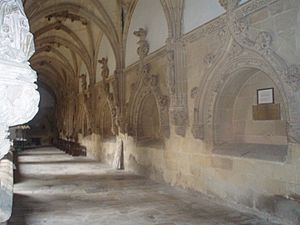Salvador González facts for kids
Salvador González was a nobleman from Castile. He lived in the 1000s and was active in the areas of La Bureba and Burgos. He was very loyal to the ruler of Castile throughout his life. Salvador González is known as the founder of an important family line, called the Salvadórez. He died in the year 1067.
Contents
Family History
Salvador's last name, González, means "son of Gonzalo." However, historians are not completely sure who his father Gonzalo was. Because of this, Salvador is the earliest known member of his family. This family is now known as the Salvadórez. Some historians believe his family might be connected to the important house of Lara family. This connection might be through Salvador's brother, Count Munio González. Munio's son, Gonzalo Muñoz, is considered the first member of the Lara family line.
Salvador González married Mumadona Álvarez. They were likely married before 1042. They had two sons, Gonzalo Salvadórez and Álvaro Salvadórez. They also had a third son named Martín.
Managing Land in Bureba
Salvador González first appears in historical records in 1031. He signed a document as a witness for a woman named Doña Goto. She formally adopted King Sancho Garcés III of Pamplona and his queen as her heirs. Doña Goto owned many villages in the Bureba region. This shows that Salvador had power and importance in the Bureba area. He might have managed this region for the king. His family would continue to do this later on.
After King Sancho died in 1035, Salvador chose to serve King Fernando. Fernando was the count of Castile and later became king of León. The Bureba region, which used to be part of Castile, went to Pamplona after 1035. So, Salvador's main activities moved west. He became more active in the Burgos region. He also worked closely with the monastery of San Pedro de Cardeña. Even so, he still had some land in the Bureba. For example, in 1040, he was managing the land of Arreba for King García.
Working Around Burgos
Salvador González worked closely with the monastery of San Pedro de Cardeña. He often signed documents related to their land deals. These deals were for land in Castile, south of the Sierra de Atapuerca mountains. He worked most closely with the monastery between 1047 and 1058.
In 1047, Salvador and his wife made a will. They left property to the monastery. Later that year, he confirmed a gift from his wife's relatives to the monastery. He also confirmed land purchases by Bishop Gómez of Burgos in 1048, 1050, and 1052. His signature helped make these deals official. In 1050, he confirmed the bishop giving some family lands to Cardeña. He also witnessed the king and queen giving two monasteries to the bishop and the abbot.
In 1058, Salvador confirmed a will made by Nuño Álvarez. This will gave property to the monastery for the soul of Nuño's late wife. This was the last document Salvador signed for the Cardeña monastery. After this, his sons became more important in Castile. In 1056, Salvador and his son Gonzalo confirmed a gift from King Fernando to the monastery of Oña. They also confirmed a gift to San Millán de la Cogolla in 1062.
Death and Burial
After King Fernando died in 1065, Salvador remained loyal to the new king of Castile, Sancho II. This meant he still didn't have much power in the Bureba region. In 1067, Castile gained control of the Bureba after a war with Pamplona. Salvador would likely have returned to manage his old lands. However, he died around that time.
On December 11, King Sancho visited Oña. Salvador was buried there. The king gave another monastery to Oña, and Salvador's two sons were important witnesses to this gift. Salvador's son Gonzalo was also buried at Oña in 1083. Gonzalo's son, Gómez González, and grandson, Rodrigo Gómez, were also buried there.
Salvador was never called a "count." This title was usually for noblemen who were very close to the royal court. Instead, he was often called senior, which means "lord" or "sir." In documents from Cardeña, he was usually called domno, which also means "lord."
Sources
See also
 In Spanish: Salvador González, tenente en La Bureba para niños
In Spanish: Salvador González, tenente en La Bureba para niños


